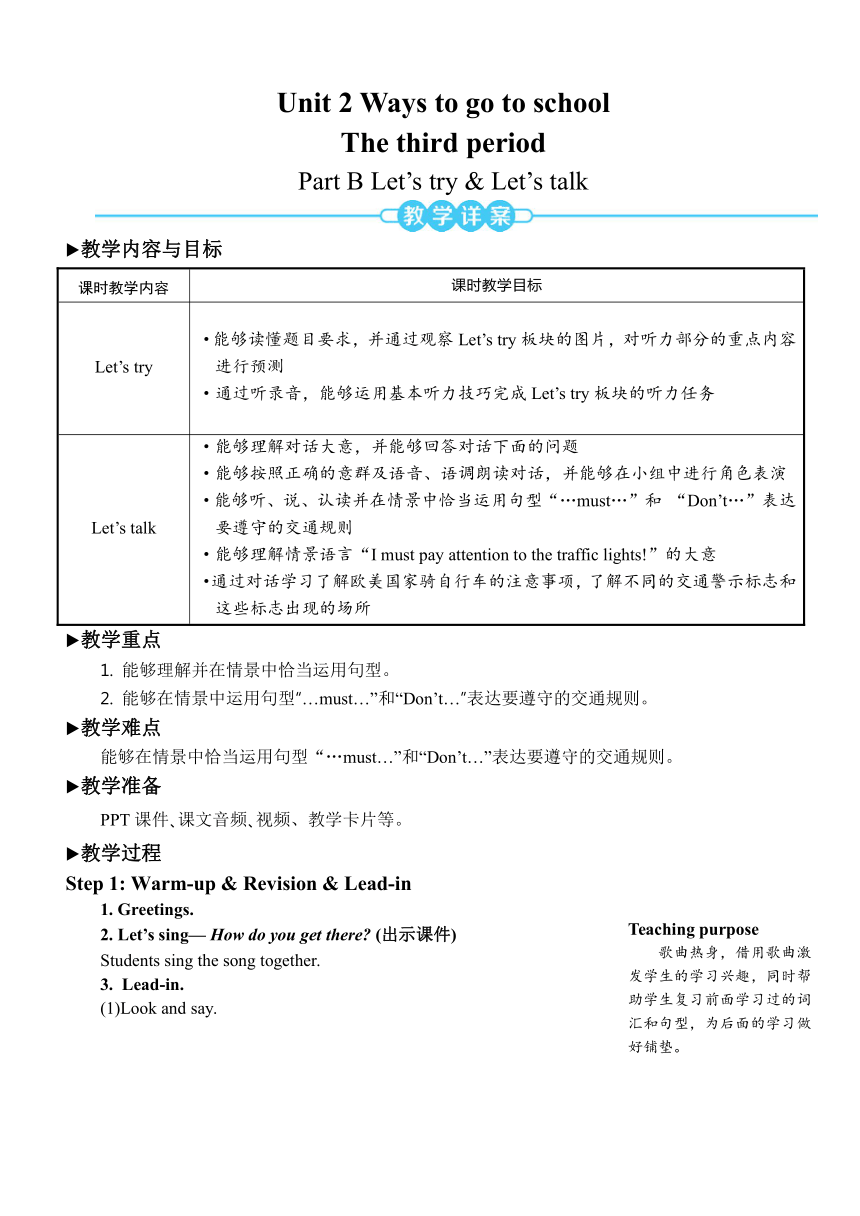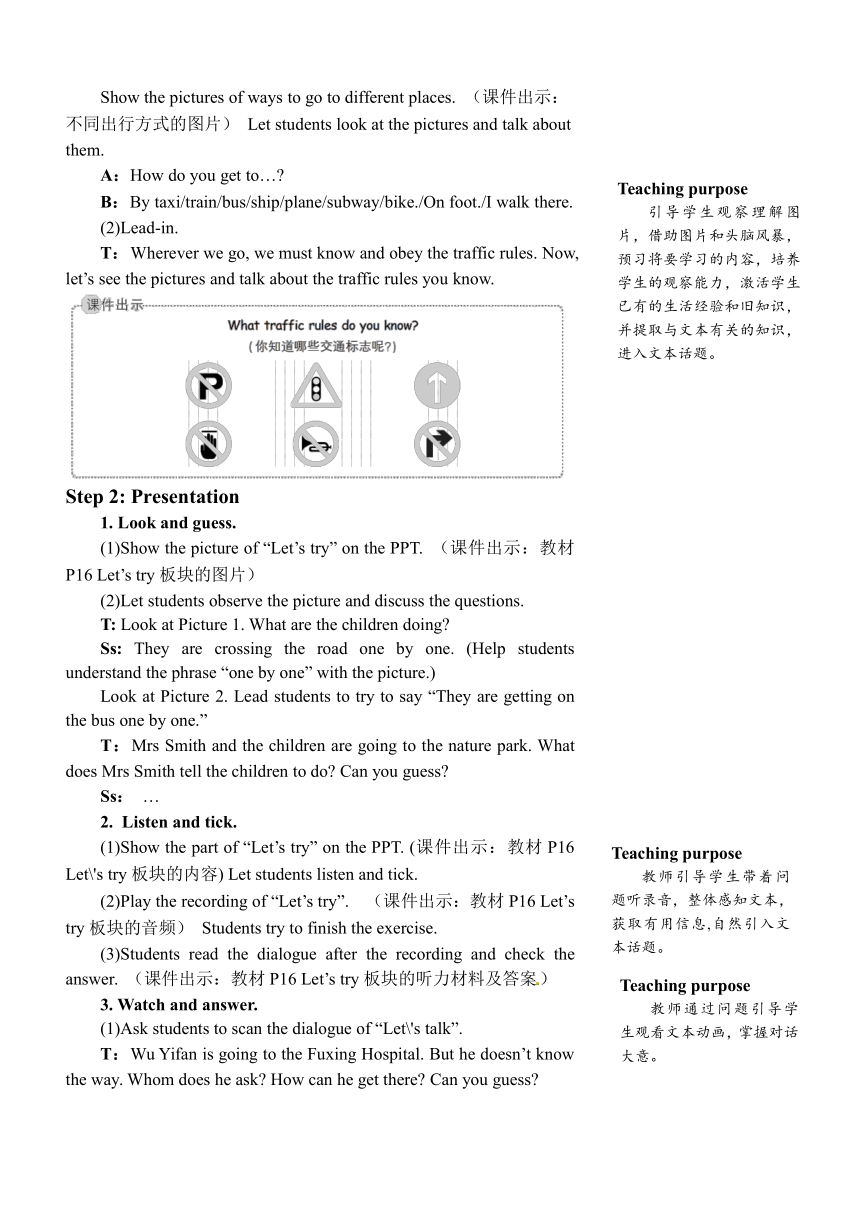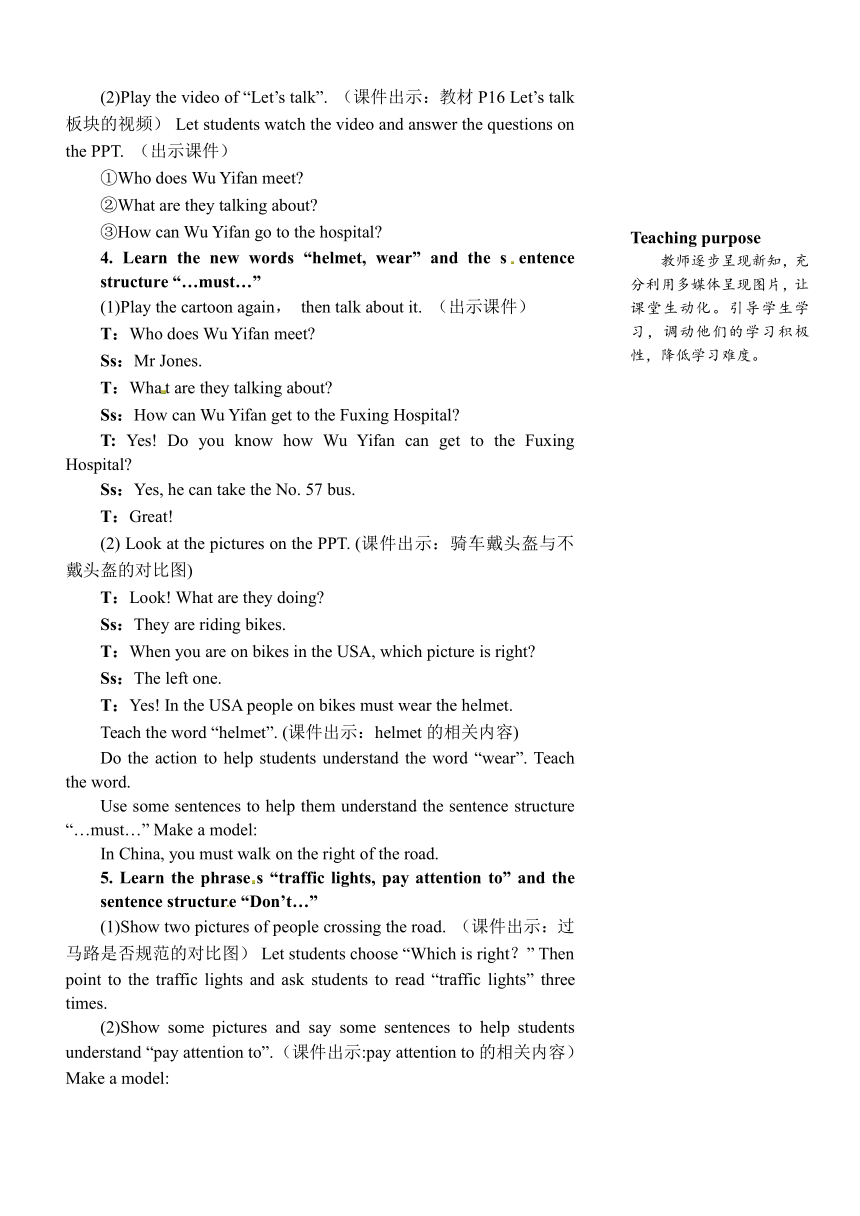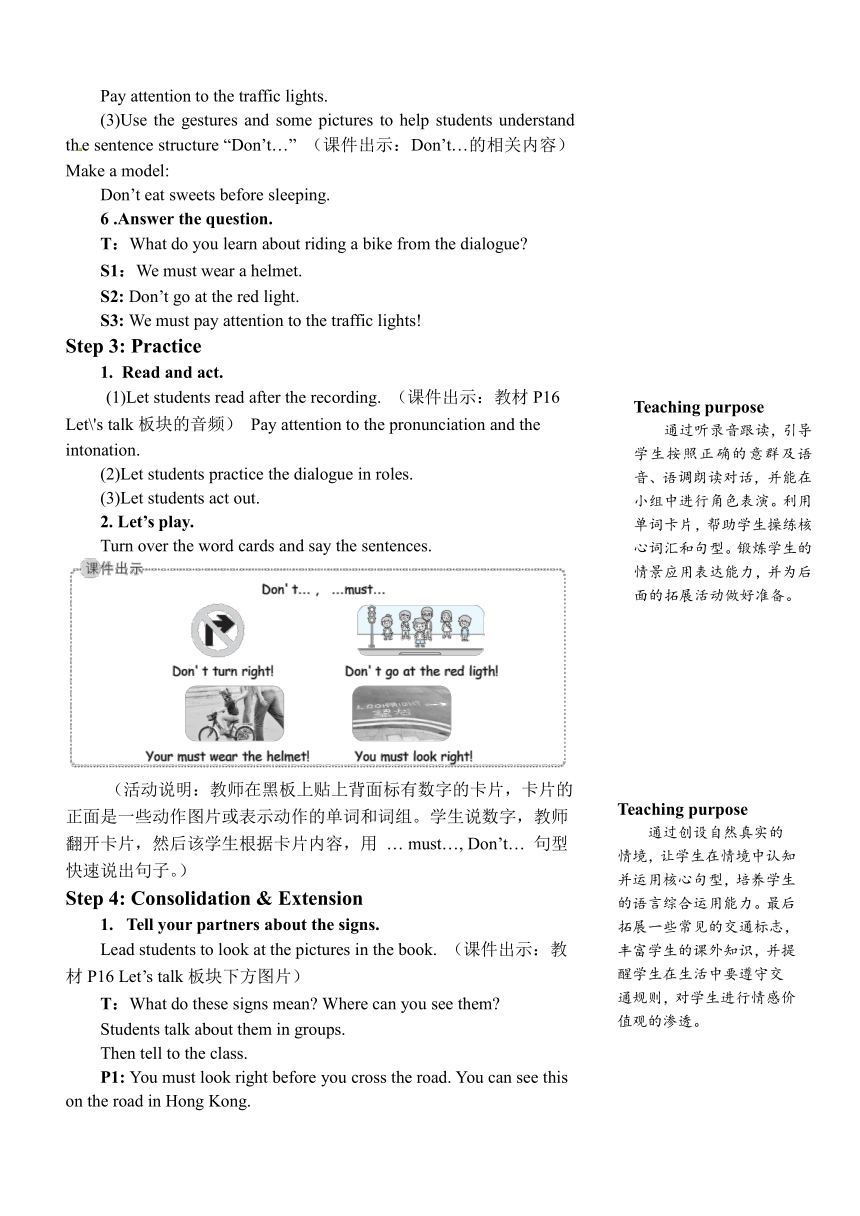Unit 2 Ways to go to school Part B Let’s talk 教案(含反思,详案与简案)
文档属性
| 名称 | Unit 2 Ways to go to school Part B Let’s talk 教案(含反思,详案与简案) |  | |
| 格式 | zip | ||
| 文件大小 | 401.6KB | ||
| 资源类型 | 教案 | ||
| 版本资源 | 人教版(PEP) | ||
| 科目 | 英语 | ||
| 更新时间 | 2020-06-12 14:25:50 | ||
图片预览




文档简介
Unit
2
Ways
to
go
to
school
The
third
period
Part
B
Let’s
try
&
Let’s
talk
?教学内容与目标
课时教学内容
课时教学目标
Let’s
try
·能够读懂题目要求,并通过观察Let’s
try板块的图片,对听力部分的重点内容进行预测·通过听录音,能够运用基本听力技巧完成Let’s
try板块的听力任务
Let’s
talk
·能够理解对话大意,并能够回答对话下面的问题·能够按照正确的意群及语音、语调朗读对话,并能够在小组中进行角色表演·能够听、说、认读并在情景中恰当运用句型“…must…”和
“Don’t…”表达要遵守的交通规则·能够理解情景语言“I
must
pay
attention
to
the
traffic
lights!”的大意·通过对话学习了解欧美国家骑自行车的注意事项,了解不同的交通警示标志和这些标志出现的场所
?教学重点
能够理解并在情景中恰当运用句型。
能够在情景中运用句型“…must…”和“Don’t…”表达要遵守的交通规则。
?教学难点
能够在情景中恰当运用句型“…must…”和“Don’t…”表达要遵守的交通规则。
?教学准备
PPT课件?课文音频?视频、教学卡片等。
?教学过程
Step
1:
Warm-up
&
Revision
&
Lead-in
1.
Greetings.
2.
Let’s
sing—
How
do
you
get
there?
(出示课件)
Students
sing
the
song
together.
Lead-in.
(1)Look
and
say.
Show
the
pictures
of
ways
to
go
to
different
places.
(课件出示:不同出行方式的图片)
Let
students
look
at
the
pictures
and
talk
about
them.
A:How
do
you
get
to…?
B:
By
taxi/train/bus/ship/plane/subway/bike./On
foot./I
walk
there.
(2)Lead-in.
T:
Wherever
we
go,
we
must
know
and
obey
the
traffic
rules.
Now,
let’s
see
the
pictures
and
talk
about
the
traffic
rules
you
know.
Step
2:
Presentation
1.
Look
and
guess.
(1)Show
the
picture
of
“Let’s
try”
on
the
PPT.
(课件出示:教材P16
Let’s
try板块的图片)
(2)Let
students
observe
the
picture
and
discuss
the
questions.
T:
Look
at
Picture
1.
What
are
the
children
doing?
Ss:
They
are
crossing
the
road
one
by
one.
(Help
students
understand
the
phrase
“one
by
one”
with
the
picture.)
Look
at
Picture
2.
Lead
students
to
try
to
say
“They
are
getting
on
the
bus
one
by
one.”
T:Mrs
Smith
and
the
children
are
going
to
the
nature
park.
What
does
Mrs
Smith
tell
the
children
to
do?
Can
you
guess?
Ss:
…
Listen
and
tick.
(1)Show
the
part
of
“Let’s
try”
on
the
PPT.
(课件出示:教材P16
Let\'s
try板块的内容)
Let
students
listen
and
tick.
(2)Play
the
recording
of
“Let’s
try”.
(课件出示:教材P16
Let’s
try板块的音频)
Students
try
to
finish
the
exercise.
(3)Students
read
the
dialogue
after
the
recording
and
check
the
answer.
(课件出示:教材P16
Let’s
try板块的听力材料及答案)
3.
Watch
and
answer.
(1)Ask
students
to
scan
the
dialogue
of
“Let\'s
talk”.
T:Wu
Yifan
is
going
to
the
Fuxing
Hospital.
But
he
doesn’t
know
the
way.
Whom
does
he
ask?
How
can
he
get
there?
Can
you
guess?
(2)Play
the
video
of
“Let’s
talk”.
(课件出示:教材P16
Let’s
talk
板块的视频)
Let
students
watch
the
video
and
answer
the
questions
on
the
PPT.
(出示课件)
①Who
does
Wu
Yifan
meet?
②What
are
they
talking
about?
③How
can
Wu
Yifan
go
to
the
hospital?
4.
Learn
the
new
words
“helmet,
wear”
and
the
sentence
structure
“…must…”
(1)Play
the
cartoon
again,
then
talk
about
it.
(出示课件)
T:Who
does
Wu
Yifan
meet?
Ss:Mr
Jones.
T:What
are
they
talking
about?
Ss:How
can
Wu
Yifan
get
to
the
Fuxing
Hospital?
T:
Yes!
Do
you
know
how
Wu
Yifan
can
get
to
the
Fuxing
Hospital?
Ss:Yes,
he
can
take
the
No.
57
bus.
T:Great![来源:学
科
网Z
X
X
K]
(2)
Look
at
the
pictures
on
the
PPT.
(课件出示:骑车戴头盔与不戴头盔的对比图)
T:Look!
What
are
they
doing?
Ss:They
are
riding
bikes.
T:When
you
are
on
bikes
in
the
USA,
which
picture
is
right?
Ss:The
left
one.
T:Yes!
In
the
USA
people
on
bikes
must
wear
the
helmet.
Teach
the
word
“helmet”.
(课件出示:helmet的相关内容)
Do
the
action
to
help
students
understand
the
word
“wear”.
Teach
the
word.
Use
some
sentences
to
help
them
understand
the
sentence
structure
“…must…”
Make
a
model:
In
China,
you
must
walk
on
the
right
of
the
road.
5.
Learn
the
phrases
“traffic
lights,
pay
attention
to”
and
the
sentence
structure
“Don’t…”
(1)Show
two
pictures
of
people
crossing
the
road.
(课件出示:过马路是否规范的对比图)
Let
students
choose
“Which
is
right?”
Then
point
to
the
traffic
lights
and
ask
students
to
read
“traffic
lights”
three
times.
(2)Show
some
pictures
and
say
some
sentences
to
help
students
understand
“pay
attention
to”.
(课件出示:pay
attention
to的相关内容)
Make
a
model:
Pay
attention
to
the
traffic
lights.
(3)Use
the
gestures
and
some
pictures
to
help
students
understand
the
sentence
structure
“Don’t…”
(课件出示:Don’t…的相关内容)
Make
a
model:
Don’t
eat
sweets
before
sleeping.
6
.Answer
the
question.
T:What
do
you
learn
about
riding
a
bike
from
the
dialogue?
S1:We
must
wear
a
helmet.
S2:
Don’t
go
at
the
red
light.[来源:学科网ZXXK]
S3:
We
must
pay
attention
to
the
traffic
lights!
Step
3:
Practice
Read
and
act.
(1)Let
students
read
after
the
recording.
(课件出示:教材P16
Let\'s
talk板块的音频)
Pay
attention
to
the
pronunciation
and
the
intonation.
(2)Let
students
practice
the
dialogue
in
roles.
(3)Let
students
act
out.
2.
Let’s
play.
Turn
over
the
word
cards
and
say
the
sentences.
[来源:学|科|网Z|X|X|K]
(活动说明:教师在黑板上贴上背面标有数字的卡片,卡片的正面是一些动作图片或表示动作的单词和词组。学生说数字,教师翻开卡片,然后该学生根据卡片内容,用
…
must…,
Don’t…
句型快速说出句子。)
Step
4:
Consolidation
&
Extension
Tell
your
partners
about
the
signs.
Lead
students
to
look
at
the
pictures
in
the
book.
(课件出示:教材P16
Let’s
talk板块下方图片)
T:What
do
these
signs
mean?
Where
can
you
see
them?
Students
talk
about
them
in
groups.
Then
tell
to
the
class.
P1:
You
must
look
right
before
you
cross
the
road.
You
can
see
this
on
the
road
in
Hong
Kong.
P2:
You
must
stop
outside
the
stop
line
and
make
sure
it
is
safe
before
you
pass.
You
can
see
this
on
an
unguarded
railroad
crossing.
P3:
Don’t
turn
right.
You
can
see
this
at
a
crossroads.
P4:
Don’t
touch
the
door.
You
can
see
this
in
the
subway.
Different
kinds
of
signs.
Show
more
pictures
about
different
kinds
of
signs.
Introduce
more
signs
to
students
and
tell
them
to
obey
the
traffic
rules.
(课件出示:不同的交通标志图)
?板书设计
?教学反思
在本节课中,以新课标为理论指导,以学生为主体、训练为主线,利用卡片游戏,使学生在学中用,用中学,学用结合,激发学生的多元智能学习能力。
本节课以句型教学为主,配以简单的词组来运用所学句型。采用卡片、图片等多种形式来逐步引导学生操练单词、词组和句型,有效地帮助学生巩固重点词汇和句型。
呈现活动设计丰富,易操作,且具备层次感,有效地提升了学生的核心素养。以学生为本,以解决问题为导向,引导学生自主学习。
突出语用功能,联系学生和班级的实际情况,设置多个环节,环环相扣,层层深入,帮助学生在真实情景中自然地使用所学语言。
?Teaching
Contents
&
Teaching
Aims
Let’s
try
·Be
able
to
predict
the
main
content
of
the
listening
part
by
observing
the
pictures.
·Be
able
to
understand
the
recording
and
tick
the
right
answer.
Let’s
talk
·Be
able
to
understand
the
main
idea
of
the
dialogue
by
observing
the
pictures
and
answer
the
questions
above
the
dialogue.
·Be
able
to
read
the
dialogue
with
correct
pronunciation
and
intonation
and
act
out
in
groups.
·Be
able
to
use
the
sentence
structures
“…must…”
“Don’t…”
properly
in
scenes.
·Be
able
to
understand
the
sentence
“I
must
pay
attention
to
the
traffic
lights!”
·Know
about
the
tips
for
cycling
in
European
and
American
countries,
and
learn
about
the
different
traffic
warning
signs
and
the
places
where
these
signs
appear.
?Teaching
Priorities
·Be
able
to
understand
and
use
the
sentence
structures
properly
in
situations.
·Be
able
to
use
the
sentence
structures
“…must…”
“Don’t…”
to
express
the
traffic
rules
that
people
should
obey.
?Teaching
Difficulties
·Be
able
to
use
the
sentence
structures
“…must…”
“Don’t…”
to
express
the
traffic
rules
that
people
should
obey.
?Teaching
Procedures
Teaching
Stages
Teacher’
s
Activities
Students
Activities
Teaching
Purposes
Warm-up&Revision&Lead-in
1.
Greetings.2.
Let’s
sing—How
do
you
get
there?3.
Lead-in.
1.
Greetings.[来源:学_科_网Z_X_X_K]2.
Listen
and
sing
the
song.3.
Observe
and
talk
about
the
pictures.
Stimulate
students’
interest
in
learning.
Review
the
knowledge
they
have
learned
and
lead
in
the
topic.
Presentation
1.
Look
and
guess.Show
the
picture
of
“Let’s
try”
and
discuss
the
questions.2.
Listen
and
tick.
[来源:学科网ZXXK](1)Show
the
part
of
“Let’s
try”
on
the
PPT.(2)Play
the
recording
of
“Let’s
try”.(3)Check
the
answer.
1.
Observe
the
picture
and
discuss
the
questions.
2.
(1)Observe
the
part
of
“Let’s
try”
on
the
PPT.(2)Listen
and
tick.(3)Read
the
dialogue
and
check
the
answer.
Lead
students
to
predict
the
listening
content
before
listening
to
the
recording.
Cultivate
students’
observation
ability
and
logical
reasoning
ability.
Get
an
overall
perception
of
the
text
and
useful
information.
3.
Watch
and
answer.Play
the
video.
Let
students
answer
the
questions.
Scan
the
dialogue
and
guess
about
the
questions.Watch
the
video
and
answer
the
questions.
Lead
students
to
watch
the
video
and
grasp
the
general
idea
of
the
dialogue.
4.
Learn
the
new
words
“helmet,
wear”
and
the
sentence
structure
“…must…”5.
Learn
the
phrases
“traffic
lights,
pay
attention
to”
and
the
sentence
structure
“Don’t
…”
6.
Answer
the
question.
4.
Watch
the
cartoon
again
and
talk
about
it.
Learn
the
new
words
“helmet,
wear”
and
the
sentence
structure
“…must…”5.
Learn
the
new
phrases
“traffic
lights,
pay
attention
to”
and
the
sentence
structure
“Don’t…”6.
Answer
the
question
below
the
dialogue.
Lead
students
to
learn
new
words
and
new
sentence
structures
gradually.
Improve
students’
enthusiasm.Reduce
the
difficulty
of
learning.
(续表)
Teaching
Stages
Teacher’
s
Activities
Students’
Activities
Teaching
Purposes
Practice
1.
Read
and
act.
Play
the
recording.
Ask
students
to
practice
in
roles
and
act
out.2.
Let’s
play.
1.
Read
after
the
recording
and
practice
the
dialogue
in
roles.
Then
act
out.2.
Look
at
the
word
cards
and
say
sentences.
Make
sure
students
read
the
dialogue
correctly
and
fluently.
Practice
the
key
words
and
sentence
structures.
Train
students’
ability
of
expressing
in
scenes
and
prepare
for
the
next
part.
Consolidation&Extension
1.
Tell
your
partners
about
the
signs.Lead
students
to
talk
about
the
signs
in
groups.2.
Different
kinds
of
signs.Show
the
pictures.
1.
Look
at
the
pictures
in
the
book.
Talk
about
them
in
groups.
Then
tell
in
the
class.2.
Look
at
the
pictures
to
learn
more
traffic
signs.
Cultivate
students’
comprehensive
language
using
ability.
Expand
some
introduction
about
traffic
signs
to
enrich
students’
extra-curricular
knowledge.
Remind
students
to
obey
traffic
rules
in
life
to
penetrate
the
emotional
value.
Homework
Read
after
the
recording.Find
out
at
least
three
traffic
signs
in
your
life.Do
the
exercises.
Teaching
purpose
歌曲热身,借用歌曲激发学生的学习兴趣,同时帮助学生复习前面学习过的词汇和句型,为后面的学习做好铺垫。
Teaching
purpose
引导学生观察理解图片,借助图片和头脑风暴,预习将要学习的内容,培养学生的观察能力,激活学生已有的生活经验和旧知识,并提取与文本有关的知识,进入文本话题。
Teaching
purpose
教师引导学生带着问题听录音,整体感知文本,获取有用信息,自然引入文本话题。
Teaching
purpose
教师通过问题引导学生观看文本动画,掌握对话大意。
Teaching
purpose
教师逐步呈现新知,充分利用多媒体呈现图片,让课堂生动化。引导学生学习,调动他们的学习积极性,降低学习难度。
Teaching
purpose
通过听录音跟读,引导学生按照正确的意群及语音、语调朗读对话,并能在小组中进行角色表演。利用单词卡片,帮助学生操练核心词汇和句型。锻炼学生的情景应用表达能力,并为后面的拓展活动做好准备。
Teaching
purpose
通过创设自然真实的情境,让学生在情境中认知并运用核心句型,培养学生的语言综合运用能力。最后拓展一些常见的交通标志,丰富学生的课外知识,并提醒学生在生活中要遵守交通规则,对学生进行情感价值观的渗透。
2
Ways
to
go
to
school
The
third
period
Part
B
Let’s
try
&
Let’s
talk
?教学内容与目标
课时教学内容
课时教学目标
Let’s
try
·能够读懂题目要求,并通过观察Let’s
try板块的图片,对听力部分的重点内容进行预测·通过听录音,能够运用基本听力技巧完成Let’s
try板块的听力任务
Let’s
talk
·能够理解对话大意,并能够回答对话下面的问题·能够按照正确的意群及语音、语调朗读对话,并能够在小组中进行角色表演·能够听、说、认读并在情景中恰当运用句型“…must…”和
“Don’t…”表达要遵守的交通规则·能够理解情景语言“I
must
pay
attention
to
the
traffic
lights!”的大意·通过对话学习了解欧美国家骑自行车的注意事项,了解不同的交通警示标志和这些标志出现的场所
?教学重点
能够理解并在情景中恰当运用句型。
能够在情景中运用句型“…must…”和“Don’t…”表达要遵守的交通规则。
?教学难点
能够在情景中恰当运用句型“…must…”和“Don’t…”表达要遵守的交通规则。
?教学准备
PPT课件?课文音频?视频、教学卡片等。
?教学过程
Step
1:
Warm-up
&
Revision
&
Lead-in
1.
Greetings.
2.
Let’s
sing—
How
do
you
get
there?
(出示课件)
Students
sing
the
song
together.
Lead-in.
(1)Look
and
say.
Show
the
pictures
of
ways
to
go
to
different
places.
(课件出示:不同出行方式的图片)
Let
students
look
at
the
pictures
and
talk
about
them.
A:How
do
you
get
to…?
B:
By
taxi/train/bus/ship/plane/subway/bike./On
foot./I
walk
there.
(2)Lead-in.
T:
Wherever
we
go,
we
must
know
and
obey
the
traffic
rules.
Now,
let’s
see
the
pictures
and
talk
about
the
traffic
rules
you
know.
Step
2:
Presentation
1.
Look
and
guess.
(1)Show
the
picture
of
“Let’s
try”
on
the
PPT.
(课件出示:教材P16
Let’s
try板块的图片)
(2)Let
students
observe
the
picture
and
discuss
the
questions.
T:
Look
at
Picture
1.
What
are
the
children
doing?
Ss:
They
are
crossing
the
road
one
by
one.
(Help
students
understand
the
phrase
“one
by
one”
with
the
picture.)
Look
at
Picture
2.
Lead
students
to
try
to
say
“They
are
getting
on
the
bus
one
by
one.”
T:Mrs
Smith
and
the
children
are
going
to
the
nature
park.
What
does
Mrs
Smith
tell
the
children
to
do?
Can
you
guess?
Ss:
…
Listen
and
tick.
(1)Show
the
part
of
“Let’s
try”
on
the
PPT.
(课件出示:教材P16
Let\'s
try板块的内容)
Let
students
listen
and
tick.
(2)Play
the
recording
of
“Let’s
try”.
(课件出示:教材P16
Let’s
try板块的音频)
Students
try
to
finish
the
exercise.
(3)Students
read
the
dialogue
after
the
recording
and
check
the
answer.
(课件出示:教材P16
Let’s
try板块的听力材料及答案)
3.
Watch
and
answer.
(1)Ask
students
to
scan
the
dialogue
of
“Let\'s
talk”.
T:Wu
Yifan
is
going
to
the
Fuxing
Hospital.
But
he
doesn’t
know
the
way.
Whom
does
he
ask?
How
can
he
get
there?
Can
you
guess?
(2)Play
the
video
of
“Let’s
talk”.
(课件出示:教材P16
Let’s
talk
板块的视频)
Let
students
watch
the
video
and
answer
the
questions
on
the
PPT.
(出示课件)
①Who
does
Wu
Yifan
meet?
②What
are
they
talking
about?
③How
can
Wu
Yifan
go
to
the
hospital?
4.
Learn
the
new
words
“helmet,
wear”
and
the
sentence
structure
“…must…”
(1)Play
the
cartoon
again,
then
talk
about
it.
(出示课件)
T:Who
does
Wu
Yifan
meet?
Ss:Mr
Jones.
T:What
are
they
talking
about?
Ss:How
can
Wu
Yifan
get
to
the
Fuxing
Hospital?
T:
Yes!
Do
you
know
how
Wu
Yifan
can
get
to
the
Fuxing
Hospital?
Ss:Yes,
he
can
take
the
No.
57
bus.
T:Great![来源:学
科
网Z
X
X
K]
(2)
Look
at
the
pictures
on
the
PPT.
(课件出示:骑车戴头盔与不戴头盔的对比图)
T:Look!
What
are
they
doing?
Ss:They
are
riding
bikes.
T:When
you
are
on
bikes
in
the
USA,
which
picture
is
right?
Ss:The
left
one.
T:Yes!
In
the
USA
people
on
bikes
must
wear
the
helmet.
Teach
the
word
“helmet”.
(课件出示:helmet的相关内容)
Do
the
action
to
help
students
understand
the
word
“wear”.
Teach
the
word.
Use
some
sentences
to
help
them
understand
the
sentence
structure
“…must…”
Make
a
model:
In
China,
you
must
walk
on
the
right
of
the
road.
5.
Learn
the
phrases
“traffic
lights,
pay
attention
to”
and
the
sentence
structure
“Don’t…”
(1)Show
two
pictures
of
people
crossing
the
road.
(课件出示:过马路是否规范的对比图)
Let
students
choose
“Which
is
right?”
Then
point
to
the
traffic
lights
and
ask
students
to
read
“traffic
lights”
three
times.
(2)Show
some
pictures
and
say
some
sentences
to
help
students
understand
“pay
attention
to”.
(课件出示:pay
attention
to的相关内容)
Make
a
model:
Pay
attention
to
the
traffic
lights.
(3)Use
the
gestures
and
some
pictures
to
help
students
understand
the
sentence
structure
“Don’t…”
(课件出示:Don’t…的相关内容)
Make
a
model:
Don’t
eat
sweets
before
sleeping.
6
.Answer
the
question.
T:What
do
you
learn
about
riding
a
bike
from
the
dialogue?
S1:We
must
wear
a
helmet.
S2:
Don’t
go
at
the
red
light.[来源:学科网ZXXK]
S3:
We
must
pay
attention
to
the
traffic
lights!
Step
3:
Practice
Read
and
act.
(1)Let
students
read
after
the
recording.
(课件出示:教材P16
Let\'s
talk板块的音频)
Pay
attention
to
the
pronunciation
and
the
intonation.
(2)Let
students
practice
the
dialogue
in
roles.
(3)Let
students
act
out.
2.
Let’s
play.
Turn
over
the
word
cards
and
say
the
sentences.
[来源:学|科|网Z|X|X|K]
(活动说明:教师在黑板上贴上背面标有数字的卡片,卡片的正面是一些动作图片或表示动作的单词和词组。学生说数字,教师翻开卡片,然后该学生根据卡片内容,用
…
must…,
Don’t…
句型快速说出句子。)
Step
4:
Consolidation
&
Extension
Tell
your
partners
about
the
signs.
Lead
students
to
look
at
the
pictures
in
the
book.
(课件出示:教材P16
Let’s
talk板块下方图片)
T:What
do
these
signs
mean?
Where
can
you
see
them?
Students
talk
about
them
in
groups.
Then
tell
to
the
class.
P1:
You
must
look
right
before
you
cross
the
road.
You
can
see
this
on
the
road
in
Hong
Kong.
P2:
You
must
stop
outside
the
stop
line
and
make
sure
it
is
safe
before
you
pass.
You
can
see
this
on
an
unguarded
railroad
crossing.
P3:
Don’t
turn
right.
You
can
see
this
at
a
crossroads.
P4:
Don’t
touch
the
door.
You
can
see
this
in
the
subway.
Different
kinds
of
signs.
Show
more
pictures
about
different
kinds
of
signs.
Introduce
more
signs
to
students
and
tell
them
to
obey
the
traffic
rules.
(课件出示:不同的交通标志图)
?板书设计
?教学反思
在本节课中,以新课标为理论指导,以学生为主体、训练为主线,利用卡片游戏,使学生在学中用,用中学,学用结合,激发学生的多元智能学习能力。
本节课以句型教学为主,配以简单的词组来运用所学句型。采用卡片、图片等多种形式来逐步引导学生操练单词、词组和句型,有效地帮助学生巩固重点词汇和句型。
呈现活动设计丰富,易操作,且具备层次感,有效地提升了学生的核心素养。以学生为本,以解决问题为导向,引导学生自主学习。
突出语用功能,联系学生和班级的实际情况,设置多个环节,环环相扣,层层深入,帮助学生在真实情景中自然地使用所学语言。
?Teaching
Contents
&
Teaching
Aims
Let’s
try
·Be
able
to
predict
the
main
content
of
the
listening
part
by
observing
the
pictures.
·Be
able
to
understand
the
recording
and
tick
the
right
answer.
Let’s
talk
·Be
able
to
understand
the
main
idea
of
the
dialogue
by
observing
the
pictures
and
answer
the
questions
above
the
dialogue.
·Be
able
to
read
the
dialogue
with
correct
pronunciation
and
intonation
and
act
out
in
groups.
·Be
able
to
use
the
sentence
structures
“…must…”
“Don’t…”
properly
in
scenes.
·Be
able
to
understand
the
sentence
“I
must
pay
attention
to
the
traffic
lights!”
·Know
about
the
tips
for
cycling
in
European
and
American
countries,
and
learn
about
the
different
traffic
warning
signs
and
the
places
where
these
signs
appear.
?Teaching
Priorities
·Be
able
to
understand
and
use
the
sentence
structures
properly
in
situations.
·Be
able
to
use
the
sentence
structures
“…must…”
“Don’t…”
to
express
the
traffic
rules
that
people
should
obey.
?Teaching
Difficulties
·Be
able
to
use
the
sentence
structures
“…must…”
“Don’t…”
to
express
the
traffic
rules
that
people
should
obey.
?Teaching
Procedures
Teaching
Stages
Teacher’
s
Activities
Students
Activities
Teaching
Purposes
Warm-up&Revision&Lead-in
1.
Greetings.2.
Let’s
sing—How
do
you
get
there?3.
Lead-in.
1.
Greetings.[来源:学_科_网Z_X_X_K]2.
Listen
and
sing
the
song.3.
Observe
and
talk
about
the
pictures.
Stimulate
students’
interest
in
learning.
Review
the
knowledge
they
have
learned
and
lead
in
the
topic.
Presentation
1.
Look
and
guess.Show
the
picture
of
“Let’s
try”
and
discuss
the
questions.2.
Listen
and
tick.
[来源:学科网ZXXK](1)Show
the
part
of
“Let’s
try”
on
the
PPT.(2)Play
the
recording
of
“Let’s
try”.(3)Check
the
answer.
1.
Observe
the
picture
and
discuss
the
questions.
2.
(1)Observe
the
part
of
“Let’s
try”
on
the
PPT.(2)Listen
and
tick.(3)Read
the
dialogue
and
check
the
answer.
Lead
students
to
predict
the
listening
content
before
listening
to
the
recording.
Cultivate
students’
observation
ability
and
logical
reasoning
ability.
Get
an
overall
perception
of
the
text
and
useful
information.
3.
Watch
and
answer.Play
the
video.
Let
students
answer
the
questions.
Scan
the
dialogue
and
guess
about
the
questions.Watch
the
video
and
answer
the
questions.
Lead
students
to
watch
the
video
and
grasp
the
general
idea
of
the
dialogue.
4.
Learn
the
new
words
“helmet,
wear”
and
the
sentence
structure
“…must…”5.
Learn
the
phrases
“traffic
lights,
pay
attention
to”
and
the
sentence
structure
“Don’t
…”
6.
Answer
the
question.
4.
Watch
the
cartoon
again
and
talk
about
it.
Learn
the
new
words
“helmet,
wear”
and
the
sentence
structure
“…must…”5.
Learn
the
new
phrases
“traffic
lights,
pay
attention
to”
and
the
sentence
structure
“Don’t…”6.
Answer
the
question
below
the
dialogue.
Lead
students
to
learn
new
words
and
new
sentence
structures
gradually.
Improve
students’
enthusiasm.Reduce
the
difficulty
of
learning.
(续表)
Teaching
Stages
Teacher’
s
Activities
Students’
Activities
Teaching
Purposes
Practice
1.
Read
and
act.
Play
the
recording.
Ask
students
to
practice
in
roles
and
act
out.2.
Let’s
play.
1.
Read
after
the
recording
and
practice
the
dialogue
in
roles.
Then
act
out.2.
Look
at
the
word
cards
and
say
sentences.
Make
sure
students
read
the
dialogue
correctly
and
fluently.
Practice
the
key
words
and
sentence
structures.
Train
students’
ability
of
expressing
in
scenes
and
prepare
for
the
next
part.
Consolidation&Extension
1.
Tell
your
partners
about
the
signs.Lead
students
to
talk
about
the
signs
in
groups.2.
Different
kinds
of
signs.Show
the
pictures.
1.
Look
at
the
pictures
in
the
book.
Talk
about
them
in
groups.
Then
tell
in
the
class.2.
Look
at
the
pictures
to
learn
more
traffic
signs.
Cultivate
students’
comprehensive
language
using
ability.
Expand
some
introduction
about
traffic
signs
to
enrich
students’
extra-curricular
knowledge.
Remind
students
to
obey
traffic
rules
in
life
to
penetrate
the
emotional
value.
Homework
Read
after
the
recording.Find
out
at
least
three
traffic
signs
in
your
life.Do
the
exercises.
Teaching
purpose
歌曲热身,借用歌曲激发学生的学习兴趣,同时帮助学生复习前面学习过的词汇和句型,为后面的学习做好铺垫。
Teaching
purpose
引导学生观察理解图片,借助图片和头脑风暴,预习将要学习的内容,培养学生的观察能力,激活学生已有的生活经验和旧知识,并提取与文本有关的知识,进入文本话题。
Teaching
purpose
教师引导学生带着问题听录音,整体感知文本,获取有用信息,自然引入文本话题。
Teaching
purpose
教师通过问题引导学生观看文本动画,掌握对话大意。
Teaching
purpose
教师逐步呈现新知,充分利用多媒体呈现图片,让课堂生动化。引导学生学习,调动他们的学习积极性,降低学习难度。
Teaching
purpose
通过听录音跟读,引导学生按照正确的意群及语音、语调朗读对话,并能在小组中进行角色表演。利用单词卡片,帮助学生操练核心词汇和句型。锻炼学生的情景应用表达能力,并为后面的拓展活动做好准备。
Teaching
purpose
通过创设自然真实的情境,让学生在情境中认知并运用核心句型,培养学生的语言综合运用能力。最后拓展一些常见的交通标志,丰富学生的课外知识,并提醒学生在生活中要遵守交通规则,对学生进行情感价值观的渗透。
同课章节目录
